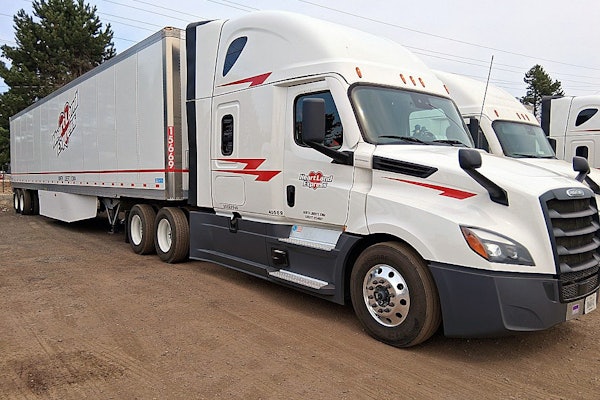Freight Transportation Services Index fell 0.7 percent in September from its August level, declining for the fifth time in the last six months, the U.S. Department of Transportation’s Bureau of Transportation Statistics reported. The September fall was the largest decline since November 2006 and the sixth decline this year. At 108.1, the Freight TSI is at its lowest level since January 2004 and is down 4.5 percent from its peak of 113.1 achieved in November 2005.
Ryder Integrated Logistics dropped its protest of a $1.6 billion Defense Transportation Coordination Initiative contract award to Menlo Worldwide Government Services. Ryder had alleged that freight management technology to be used by Menlo subcontractor One Network was untested and was released six days after the contract was awarded.
House Transportation and Infrastructure Committee approved legislation (H.R. 3999) that would authorize $2 billion to identify and rehabilitate structurally deficient bridges across the United States and reform bridge management practices.
New York Gov. Eliot Spitzer dropped his proposal to allow illegal immigrants to obtain driver’s licenses.
Chrysler plans to cut 8,500 to 10,000 hourly jobs through 2008 and reduce salaried employment by about 2,100, reducing its work force by as much as 15 percent. The new round of cuts comes in addition to 13,000 layoffs Chrysler announced in February as part of a major restructuring.
Old Dominion Freight Line said Chairman and Chief Executive Officer Earl Congdon, 76, plans to retire from his duties as CEO, effective Dec. 31. He will continue as executive chairman. David Congdon, currently president and chief operating officer, will become president and
CEO. Executive Vice President John Yowell will add COO to
his title.
Pacer International announced that its president, Tom Shurstad, left the company to pursue other interests. Don Orris, retired chief exe-cutive officer and current director of the Concord, Calif.-based company, assumed the role of president of its intermodal segment.
UPS Freight beginning Jan. 2 will offer its less-than-truckload shippers using the current UPS Freight 560 tariff in the continental United States a money-back guarantee for on-time performance reliability.
USF Holland, an operating unit of YRC Regional Transportation, has accelerated delivery times between cities on 13 lanes, primarily in the Midwest.
United Road Services, a Romulus, Mich.-based provider of vehicle logistics services, was acquired by the Gores Group, a private investment firm, from Charterhouse Equity Partners III, L.P. Terms were not disclosed.
The Federal Motor Carrier Safety Administration’s cross-border pilot program last month edged closer to its likely demise when the House of Representatives approved the conference report on the transportation funding bill (H.R. 3074) by a 270 to 147 vote. The Senate did not vote on the bill before Congress left on a two-week Thanksgiving recess on Nov. 16. Funding for the federal government is in place through Dec. 14.
The conference report (House Report 110-446) includes a provision that “none of the funds may be used to establish a cross-border motor carrier demonstration program to allow Mexico-domiciled motor carriers to operate beyond the commercial zones along the international border between the United States and Mexico.” The language, if adopted, would effectively kill the pilot program, at least through the end of September 2008.
FMCSA and the Department of Transportation have been trying to win support for the program, which has been in place since Sept. 6. The pilot project allows a limited number of Mexican trucking companies to operate beyond the 25-mile commercial zone in the United States. Under a reciprocity agreement with Mexico, the one-year pilot program also allows a limited number of U.S. carriers to operate into Mexico.
In a Nov. 14 letter to the House, the White House Office of Management and Budget threatened a veto of H.R. 3074 if it passed both the House and Senate in its current form. But nowhere in the policy statement did the Bush administration suggest that the funding prohibition on the Mexico program was a problem. Rather, the White House argued that H.R. 3074 spends too much and contains too much pork.
The one-year pilot program isn’t necessarily doomed, however. One scenario is that wrangling over transportation spending is never resolved and that Congress simply continues the status quo. Or Congress could offer the Bush administration continuation of the program as part of a compromise. Neither scenario is likely, though.
Meanwhile, FMCSA has continued to clear more carriers for participation in the program. As of Nov. 21, seven Mexican carriers and four U.S. carriers are authorized.
-Avery Vise
L.A., Long Beach ports phase out older trucks
Pre-2007 technology to be banned after 2011
Harbor commissioners for Los Angeles and Long Beach last month separately approved a tariff that will phase out by Jan. 1, 2012, drayage trucks at the Port of Los Angeles and the Port of Long Beach that don’t meet 2007 or later federal emissions standards. Harbor commission approval is sufficient authority for the tariff at the Port of Long Beach. The Port of Los Angeles tariff also must be approved by Los Angeles’ mayor and city council.
The schedule for the progressive ban is:
* Oct. 1, 2008: All pre-1989 trucks will be banned from port service.
* Jan. 1, 2010: 1989-1993 trucks will be banned, along with unretrofitted 1994-2003 trucks.
* Jan. 1, 2012: All trucks that do not meet the 2007 federal standard will be banned.
“This tariff sets into motion our goal of modernizing the fleet of trucks that serve our ports by either replacing or retrofitting them to attain substantially lower emissions,” said Port of Los Angeles Executive Director Geraldine Knatz, Ph.D. Knatz added that the purpose of the phaseout is to meet the health standard the two harbor commissions set last year in the San Pedro Bay Ports Clean Air Action Plan.
The ports will rely on an electronic identification system such as radio frequency identification (RFID) to enforce the ban. RFID tags or similar technology will be placed in trucks, and tag readers will be installed at port terminal gates to ensure access only for authorized trucks.
House panel eyes drug testing program
GAO finds testing procedures lacking
Truck drivers who want to thwart regulations aimed at detecting use of drugs and alcohol could take advantage of lax collection procedures and products intended to mask drug use, the General Accounting Office told a U.S. House subcommittee overseeing motor carriers last month. With an initial hearing on Nov. 1, the House Transportation and Infrastructure subcommittee on highways and transit began looking at whether the regulations to thwart the use of drugs and alcohol need updating.
GAO undercover investigators who used fake commercial driver’s licenses to gain access to 24 drug-testing sites found that 75 percent “failed to restrict access to items that could be used to adulterate or dilute the [urine] specimen, meaning that running water, soap or air freshener was available in the bathroom during the test.” The GAO team also bought drug-masking products over the Web and was able to mix them with real specimens at the drug-testing sites “without being caught by site collectors,” the agency said. Drug-screening labs never realized that there was a problem: “Every drug-masking product went undetected by the drug screening labs,” GAO said.
Rep. Jim Oberstar, D-Minn., chairman of the House Transportation and Infrastructure Committee, who asked GAO to investigate, said the GAO report was “frankly astonishing and shocking and dismaying. You can manipulate the tests, you can mask substance abuse and go undetected on the roadways.” Oberstar said the drug-testing system was broken and was placing other drivers in danger. “It fails, it is not sufficient, it is not protecting the public interest,” he said.
The American Trucking Associations recommended that the subcommittee support five specific enhancements to drug and alcohol testing rules and procedures:
* A centralized clearinghouse for positive drug and alcohol testing results of commercial drivers (See “Journal,” September 2007);
* An incentive-based random testing policy that would focus more resources on carriers with higher-than-average positive test results;
* A ban on the manufacture, sale and distribution of products that help drivers evade drug tests, as well as penalties for using such products;
* A rulemaking from the Department of Transportation and the Substance Abuse and Mental Health Services Administration that allows the testing of hair as an alternative to urine; and
* Improvements in the oversight of specimen collection facilities and practices.
One of the major challenges in fighting drug use is that it’s difficult today for the system to monitor job-hoppers and independent owner-operators, John Hill, administrator of the Federal Motor Carrier Safety Administration, told the subcommittee. Mechanisms under review include a national clearinghouse of positive test results, a process for identifying drivers who fail to comply with the return-to-duty process, and state-based efforts to require reporting of positive tests to state agencies. For example, two states – North Carolina and Washington – take action to revoke or suspend the commercial driver’s license until the driver proves he is in compliance with the return-to-duty requirements, Hill said.
Others participating in the Nov. 1 hearing included the Owner-Operator Independent Drivers Association and the Teamsters union. Copies of all the prepared testimony are available at http://transportation.house.gov/hearings.
M & M’s Hayden receives image award
The American Trucking Associations presented Don Hayden, president of M & M Cartage Co. Inc., with the inaugural Mike Russell “Good stuff” Trucking Image Award during ATA’s annual Management Conference & Exhibition Oct. 20-23 in Orlando, Fla. The award was created to honor those that creatively implement the “Good stuff. Trucks Bring It” campaign in order to generate positive awareness of the trucking industry.
“Don has been extremely active in promoting the positive image of trucking through the ‘Good stuff. Trucks Bring It’ campaign,” said Bill Graves, ATA president and chief executive officer. “Whether delivering relief supplies to hurricane victims in a ‘Good stuff’-wrapped trailer, or working with the Kentucky Motor Transport Association to let the local media and public know how essential the trucking industry is to our economy, Don’s enthusiasm for the industry shines through.”
Submissions were evaluated by an impartial panel of judges based on creativity, execution and reach/impact. The award is named in honor of the late Mike Russell, who as ATA’s vice president of public affairs helped develop the “Good stuff. Trucks Bring It” campaign.
For more information on the campaign, go to www.trucksbringit.com.
Forecast calls for a year of $3-plus diesel
Diesel prices likely won’t fall below $3 per gallon again until November 2008, and even then the decrease will be slight, according to a U.S. Energy Information Administration specialist. “Oil will still stay well above $80 a barrel,” says Jonathan Cogan. “The big driver of prices now is high crude oil prices, and the price of everything made from it has gone up.”
Diesel is expected to average $3.18 per gallon in December 2007 and will continue to drop slightly through March 2008, when it will average $3.13 per gallon, Cogan says. Winter months increase demand for the distillate from which both diesel fuel and heating oil are made. When heating oil season ends, in February or March, a minor price drop for diesel will result.
In April, however, diesel will begin its climb to a predicted high in May of $3.18 per gallon, then descend in price from June through December 2008, Cogan says. Diesel is forecast to average $2.96 per gallon in December 2008, a low for the year, Cogan says.
“There will be some easing of crude oil prices because prices cannot be sustained at this level,” Cogan says. Contributing to a slight drop in oil prices will be a mild softening of the U.S. economy and slightly increased production by nations both inside and outside the Organization of Petroleum Exporting Countries, Cogan says.
Several factors contributed to crude oil’s dramatic price increase this year. West Texas Intermediate prices shot from an average of nearly $55 per barrel in January to more than $95 per barrel in early November. “Previous oil shocks were driven by disruption, such as the 1973 Arab oil embargo,” Cogan says. While there is still disruption in oil-producing countries, notably Iraq, fuel demand is much stronger worldwide, especially in Asia.
Besides strong worldwide economic growth, other causes of price shock include:
- Only moderate supply growth among non-OPEC countries;
- OPEC production decisions and low OPEC spare production capacity;
- The tightness of global commercial inventories;
- Worldwide refining bottlenecks; and
- Ongoing geopolitical troubles.
– Jill Dunn
Tougher fuel economy ordered for light trucks
Saying that the federal government failed to consider the benefits of reducing carbon dioxide (CO2) emissions, the U.S. Court of Appeals for the Ninth Circuit ruled Nov. 15 that the National Highway Traffic Safety Administration must go back to the drawing board and develop new corporate average fuel economy (CAFE) standards for light trucks. Another problem the court had with the NHTSA rule – one of particular interest to commercial fleet owners – was the exclusion of most vehicles rated between 8,500 and 10,000 pounds gross vehicle weight from fuel economy regulation.
Eleven states, the District of Columbia, the City of New York along with Public Citizen, Environmental Defense, the Natural Resources Defense Council and the Sierra Club challenged NHTSA’s fuel economy standards as too weak. Placing a monetary value on CO2 reductions would have justified more stringent standards, they argued.
The states and public interest groups also contended that the new standards should have guaranteed a minimum average fuel economy, not one that varied according to a manufacturer’s fleet mix. They further challenged the rule because it failed to close the so-called “SUV loophole” that allows sport utility vehicles, minivans and pickup trucks to satisfy a lower fuel economy standard than cars.
In a 90-page decision, the court sided with the states and interest groups on each of those points. It ordered NHTSA to issue new standards “as expeditiously as possible and for the earliest model year practicable.” The appeals court did not, however, throw out the current standards, which remain in place until the new standards are issued.
Supreme Court accepts Washington state overtime ruling
The U.S. Supreme Court last month refused to hear an appeal of a Washington state Supreme Court ruling declaring that truck drivers are entitled to overtime pay beyond 40 hours regardless of how much of their driving took place in the state. The effect of the court’s action is to end legal challenges to the overtime ruling by the trucking company involved, Food Express, joined by the Washington Trucking Association and the American Trucking Associations.
Washington’s minimum wage law “unambiguously requires that overtime be paid to a Washington employee based on all hours worked,” Justice Barbara Madsen wrote for the majority in the March 1 decision.
ATA and WTA had filed an amicus brief before the U.S. Supreme Court in support of the Food Express appeal. The associations argued that the Washington state ruling, which overturned almost 20 years of precedent, would inject the state’s overtime regulatory system into other states in violation of the Constitution’s Commerce Clause and preemption of state interference in carrier’s rates, routes and services.
White House reviews HOS rule
The Federal Motor Carrier Safety Administration on Nov. 27 submitted to the White House Office of Management and Budget an interim final rule concerning the hours-of-service regulations. The document responds to the ruling of the U.S. Court of Appeals for the District of Columbia Circuit, which voided two provisions – the 11 hours of driving and 34-hour restart – in a July 24 decision. In late September, the court stayed its decision until Dec. 27 in response to a request from the American Trucking Associations. FMCSA supported ATA’s request, which was for an eight-month stay, but asked that the stay remain in place for a year.
Details of the interim rule were unavailable at CCJ’s press time, although it was likely to preserve in some way the 11 hours of driving and 34-hour restart – at least pending further consideration. For more information, visit www.ccjmagazine.com.
Midwestern states to cut greenhouse gases
The governors of nine U.S. states and the premier of Manitoba last month agreed to take certain steps to cut greenhouse gases like carbon monoxide and to reduce dependence on foreign oil. The governors signed the Midwestern Regional Greenhouse Gas Reduction Accord at the Midwestern Governors Association (MGA) Energy Security and Climate Change Summit, representing Illinois, Indiana, Iowa, Kansas, Michigan, Minnesota, Ohio, South Dakota and Wisconsin.
Under the accord, MGA member states would develop a market-based and multi-sector cap-and-trade mechanism to help achieve reduction targets, which are to be established within a year in each state. Targets would be consistent with the 60 to 80 percent recommended by the Intergovernmental Panel on Climate Change. States would join The Climate Registry as a way to track, manage and credit entities that reduce greenhouse gas emissions.
For more information, go to www.midwesterngovernors.org/energysummit.htm.
Tonnage index dips in October
The American Trucking Associations’ advanced seasonally adjusted For-Hire Truck Tonnage Index decreased 0.3 percent in October, after rising 1.5 percent in September. The not-seasonally adjusted index gained 14.0 percent from September to 122.1.
On a seasonally adjusted basis, the tonnage index slipped to 110.9 in October. Tonnage also was down 1.5 percent from a year earlier. Year-to-date, the tonnage index was 2.2 percent lower than during the same period in 2006.
With only two months of data remaining for the year, the 2007 decrease could be the largest annual drop since a 5.2 percent reduction in 2000. The index fell 1.7 percent in 2006.
ATA Chief Economist Bob Costello said the October tonnage reading illustrates continued softness in truck tonnage. Although the weak freight environment is broad-based, the housing sector was a significant contributor to the decline and continues to affect flatbed carriers.
Provided the U.S. economy doesn’t slip into a recession, Costello expects freight levels will remain soft until the second half of 2008. “We anticipate truck freight volumes to be lackluster for the next couple of quarters,” Costello said. “There is nothing on the horizon that points to an acceleration in truck freight.”
ATA calculates the tonnage index based on surveys from its membership and has been doing so since the 1970s. The baseline year for the index is 2000.
CCJ Hotspots: Arkansas rejoins the elite
After a one-month break, Arkansas rejoined the CCJ Hot Spots in October. Arkansas had been among the three hottest spot-market states for five consecutive months until being replaced in September by Ohio, according to CCJ Hotspots data. Meanwhile, Illinois was a Hot Spot for the third consecutive month in October, and Ohio repeated.
In cooperation with freight-matching leader TransCore, we highlight the nation’s three hottest states – those where the outbound load-to-truck imbalance is most in favor of the carrier. We then pair these states with market rate data to identify the three best outbound paying lanes by each of the three most popular equipment types – van, reefer and flatbed. And like the three origin states, all of these destination states have positive load-to-truck ratios. Load-to-truck ratio and market rate data are courtesy of TransCore. The goal is to highlight not only the best states for spot-market freight but also the best outbound opportunities from those states.
| Illinois (Outbound) | ||||||
| Destination State | Avg Rate | Min Rate | Max Rate | Avg Fuel Surcharge | Avg Accessorial | |
| Van | ||||||
| ID | 1.9035 | 1.7918 | 2.0153 | 0.33 | 553.84 | |
| WV | 1.8756 | 1.5631 | 2.1881 | 0.29 | 188.8 | |
| GA | 1.5737 | 1.3812 | 1.7662 | 0.26 | 212.17 | |
| Reefer | ||||||
| WV | 2.2883 | 2.0815 | 2.4951 | 0.2 | 340.14 | |
| OH | 2.2395 | 1.9151 | 2.5638 | 0.21 | 259.59 | |
| AL | 1.9915 | 1.7991 | 2.1839 | 0.29 | 287.69 | |
| Flatbed | ||||||
| WV | 1.8479 | 1.6188 | 2.0769 | 0.16 | 97.56 | |
| CA | 1.6788 | 1.5922 | 1.7653 | 0.28 | 789.36 | |
| GA | 1.659 | 1.3413 | 1.9768 | 0.17 | 148.42 | |
| Ohio (Outbound) | ||||||
| Destination State | Avg Rate | Min Rate | Max Rate | Avg Fuel Surcharge | Avg Accessorial | |
| Van | ||||||
| ID | 1.6786 | 1.2633 | 2.1243 | 0.32 | 669.83 | |
| GA | 1.5061 | 1.3331 | 1.6791 | 0.26 | 179.96 | |
| AL | 1.5057 | 1.3116 | 1.6999 | 0.25 | 198.9 | |
| Reefer | ||||||
| GA | 1.6363 | 1.4581 | 1.8144 | 0.17 | 219.09 | |
| SC | 1.5811 | 1.4016 | 1.7607 | 0.14 | 191.1 | |
| AL | 1.5506 | 1.3493 | 1.7519 | 0.17 | 294.95 | |
| Flatbed | ||||||
| TN | 1.7529 | 1.5489 | 1.9569 | 0.17 | 81.61 | |
| AR | 1.7509 | 1.4183 | 2.0835 | 0.21 | 198.95 | |
| WI | 1.7077 | 1.4853 | 1.9301 | 0.07 | 41.62 | |
| Arkansas (Outbound) | ||||||
| Destination State | Avg Rate | Min Rate | Max Rate | Avg Fuel Surcharge | Avg Accessorial | |
| Van | ||||||
| TN | 1.8457 | 0.5519 | 3.7207 | 0.24 | 81.3 | |
| WV | 1.8451 | 1.5667 | 2.1236 | 0.27 | 235.96 | |
| ID | 1.6675 | 1.3199 | 1.9979 | 0.29 | 598 | |
| Reefer | ||||||
| AL | 2.4306 | 2.106 | 2.6241 | 0.32 | 279.53 | |
| GA | 1.8193 | 1.6036 | 2.0349 | 0.27 | 187.32 | |
| MI | 1.7982 | 1.624 | 1.9724 | 0.32 | 419.05 | |
| Flatbed | ||||||
| CA | 1.812 | 1.6427 | 1.9812 | 0.2 | 976.86 | |
| MN | 1.7846 | 1.4102 | 2.1591 | 0.15 | 151.78 | |
| WV | 1.784 | 1.6891 | 1.8788 | 0.37 | 231.98 | |









